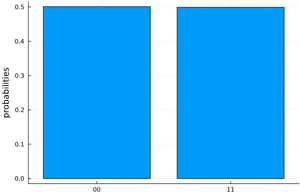Snowflurry/en: Difference between revisions
(Created page with "Snowflurry") Tags: Mobile edit Mobile web edit |
No edit summary |
||
| (28 intermediate revisions by 2 users not shown) | |||
| Line 1: | Line 1: | ||
<languages /> | <languages /> | ||
[https://github.com/SnowflurrySDK/Snowflurry.jl/ Snowflurry] is an open-source quantum computing library developed in [[Julia]] by [https://anyonsys.com/ Anyon Systems] that allows you to build, simulate, and run quantum circuits. A related library called [https://github.com/SnowflurrySDK/SnowflurryPlots.jl/ SnowflurryPlots] allows you to visualize the simulation results in a bar chart. Useful to explore quantum computing, its features are described in the [https://snowflurrysdk.github.io/Snowflurry.jl/dev/index.html documentation] and the [https://github.com/SnowflurrySDK/Snowflurry.jl installation guide is available on the GitHub page]. Like the [[PennyLane/en|PennyLane]] library, Snowflurry can be used to run quantum circuits on the [[MonarQ/en|MonarQ]] quantum computer. | |||
[https://github.com/SnowflurrySDK/Snowflurry.jl/ Snowflurry] | |||
== Installation == | |||
== Installation | The quantum computer simulator with [https://github.com/SnowflurrySDK/Snowflurry.jl Snowflurry] is available on all of our clusters. The [https://julialang.org/ Julia] programming language must be loaded before accessing Snowflurry. | ||
<includeonly> <div class="floatright"> [[File:Question.png|40px|link=https://explainshell.com/explain?cmd={{urlencode:{{{1}}} }}]] </div> <div class="command">{{#tag:syntaxhighlight|{{{prompt|[username@narval ~]$}}} {{{1}}}{{{result|}}}|lang={{{lang|bash}}}}}</div></includeonly><noinclude> | <includeonly> <div class="floatright"> [[File:Question.png|40px|link=https://explainshell.com/explain?cmd={{urlencode:{{{1}}} }}]] </div> <div class="command">{{#tag:syntaxhighlight|{{{prompt|[username@narval ~]$}}} {{{1}}}{{{result|}}}|lang={{{lang|bash}}}}}</div></includeonly><noinclude> | ||
{{Command|module load julia | {{Command|module load julia | ||
|result=}} | |result=}} | ||
</noinclude> | </noinclude> | ||
The Julia programming interface is then called and the Snowflurry quantum library is loaded (in about 5-10 minutes) with the commands | |||
<includeonly> <div class="floatright"> [[File:Question.png|40px|link=https://explainshell.com/explain?cmd={{urlencode:{{{1}}} }}]] </div> <div class="command">{{#tag:syntaxhighlight|{{{prompt|[username@narval ~]$}}} {{{1}}}{{{result|}}}|lang={{{lang|bash}}}}}</div></includeonly><noinclude> | <includeonly> <div class="floatright"> [[File:Question.png|40px|link=https://explainshell.com/explain?cmd={{urlencode:{{{1}}} }}]] </div> <div class="command">{{#tag:syntaxhighlight|{{{prompt|[username@narval ~]$}}} {{{1}}}{{{result|}}}|lang={{{lang|bash}}}}}</div></includeonly><noinclude> | ||
{{Command|julia | {{Command|julia | ||
| Line 21: | Line 16: | ||
julia> using Snowflurry}} | julia> using Snowflurry}} | ||
</noinclude> | </noinclude> | ||
Quantum logic gates and commands are described in the [https://snowflurrysdk.github.io/Snowflurry.jl/dev/ Snowflurry documentation]. <!--Le simulateur quantique de Snowflurry est appelé avec la commande [https://snowflurrysdk.github.io/Snowflurry.jl/dev/tutorials/basics.html#Circuit-Simulation simulate].--> | |||
== Use case: Bell states == | |||
Bell states are maximally entangled two-qubit states. They are simple examples of two quantum phenomena: superposition and entanglement. The [https://github.com/SnowflurrySDK/Snowflurry.jl/ Snowflurry] library allows you to construct the first Bell state as follows: | |||
<noinclude> | <noinclude> | ||
{{Command|julia | {{Command|julia | ||
| Line 34: | Line 27: | ||
julia> push!(circuit,control_x(1,2)); | julia> push!(circuit,control_x(1,2)); | ||
julia> print(circuit) | julia> print(circuit) | ||
Quantum Circuit Object: | Quantum Circuit Object: | ||
qubit_count: 2 | qubit_count: 2 | ||
| Line 44: | Line 35: | ||
}} | }} | ||
</noinclude> | </noinclude> | ||
In the above code section, the Hadamard gate creates an equal superposition of |0⟩ and |1⟩ on the first qubit while the CNOT gate (controlled X gate) creates an entanglement between the two qubits. We find an equal superposition of states |00⟩ and |11⟩, which is the first Bell state. The <code>simulate</code> function allows us to simulate the exact state of the system. | |||
<noinclude> | <noinclude> | ||
julia> state = simulate(circuit) | julia> state = simulate(circuit) | ||
| Line 54: | Line 45: | ||
0.7071067811865475 + 0.0im | 0.7071067811865475 + 0.0im | ||
</noinclude> | </noinclude> | ||
The <code>readout</code> operation lets you specify which qubits will be measured. The <code>plot_histogram</code> function from the SnowflurryPlots library allows you to visualize the results. | |||
<noinclude> | <noinclude> | ||
{{Command|julia | {{Command|julia | ||
| Line 66: | Line 55: | ||
</noinclude> | </noinclude> | ||
[[File:Bell Graph.png|thumb|alt=Résultats de 1000 simulations de l'état de Bell.]] | [[File:Bell Graph.png|thumb|alt=Résultats de 1000 simulations de l'état de Bell.]] | ||
Latest revision as of 20:38, 24 October 2024
Snowflurry is an open-source quantum computing library developed in Julia by Anyon Systems that allows you to build, simulate, and run quantum circuits. A related library called SnowflurryPlots allows you to visualize the simulation results in a bar chart. Useful to explore quantum computing, its features are described in the documentation and the installation guide is available on the GitHub page. Like the PennyLane library, Snowflurry can be used to run quantum circuits on the MonarQ quantum computer.
Installation
The quantum computer simulator with Snowflurry is available on all of our clusters. The Julia programming language must be loaded before accessing Snowflurry.
[name@server ~]$ module load julia
The Julia programming interface is then called and the Snowflurry quantum library is loaded (in about 5-10 minutes) with the commands
[name@server ~]$ julia
julia> import Pkg
julia> Pkg.add(url="https://github.com/SnowflurrySDK/Snowflurry.jl", rev="main")
julia> Pkg.add(url="https://github.com/SnowflurrySDK/SnowflurryPlots.jl", rev="main")
julia> using Snowflurry
Quantum logic gates and commands are described in the Snowflurry documentation.
Use case: Bell states
Bell states are maximally entangled two-qubit states. They are simple examples of two quantum phenomena: superposition and entanglement. The Snowflurry library allows you to construct the first Bell state as follows:
[name@server ~]$ julia
julia> using Snowflurry
julia> circuit=QuantumCircuit(qubit_count=2);
julia> push!(circuit,hadamard(1));
julia> push!(circuit,control_x(1,2));
julia> print(circuit)
Quantum Circuit Object:
qubit_count: 2
q[1]:──H────*──
¦
q[2]:───────X──
In the above code section, the Hadamard gate creates an equal superposition of |0⟩ and |1⟩ on the first qubit while the CNOT gate (controlled X gate) creates an entanglement between the two qubits. We find an equal superposition of states |00⟩ and |11⟩, which is the first Bell state. The simulate function allows us to simulate the exact state of the system.
julia> state = simulate(circuit)
julia> print(state)
4-element Ket{ComplexF64}:
0.7071067811865475 + 0.0im
0.0 + 0.0im
0.0 + 0.0im
0.7071067811865475 + 0.0im
The readout operation lets you specify which qubits will be measured. The plot_histogram function from the SnowflurryPlots library allows you to visualize the results.
[name@server ~]$ julia
julia> using SnowflurryPlots
julia> push!(circuit, readout(1,1), readout(2,2))
julia> plot_histogram(circuit,1000)
